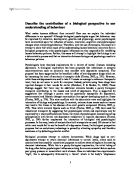Behaviour in Groups
Essay written by: Aiden Fernandez
The Psychological definition of a 'group' is broken down into 7 categories:
. Interaction - a group is a collection of individuals who are interacting with one another.
2. Perception of belonging - a group consists of 2 or more persons who perceive themselves to belong to a group.
3. Interdependence - group members are interdependent.
4. Common goals - a group is a collection of individuals who join together to achieve a goal.
5. Needs satisfaction - individuals who belong to a group are trying to satisfy some need through group membership.
6. Roles and norms - members of a group structure their interactions by means of roles and norms. Roles consist of sets of obligations and expectations. Norms imply established ways of behaving - that is, uniformity among people in the ways they behave.
7. Influence - a group is a collection of individuals who influence each other.
The study of individuals in-groups and group behaviour has been a core of social psychology since its inception in the early 1900s. One of the first "experiments" in social psychology was by Triplett in 1898, considering the effects of the presence of others on performance. The authors examine this phenomenon as well as group communication, task performance in-groups such as problem-solving and decision-making, and leadership characteristics and styles.
The definition of group that is used in most research is "people who are interdependent and have potential for mutual interaction, influencing one another in some way". Groups are defined by four specific dimensions: size, goals, duration and scope of activities performed. While groups can be a function of a wide range of these factors, experimental groups that are analysed in laboratory settings are usually small, short-lived and narrow in focus, limiting the generalizability of such findings. Groups in real-world settings must be analysed as well, in order to obtain a complete picture of the functioning of groups.
Essay written by: Aiden Fernandez
The Psychological definition of a 'group' is broken down into 7 categories:
. Interaction - a group is a collection of individuals who are interacting with one another.
2. Perception of belonging - a group consists of 2 or more persons who perceive themselves to belong to a group.
3. Interdependence - group members are interdependent.
4. Common goals - a group is a collection of individuals who join together to achieve a goal.
5. Needs satisfaction - individuals who belong to a group are trying to satisfy some need through group membership.
6. Roles and norms - members of a group structure their interactions by means of roles and norms. Roles consist of sets of obligations and expectations. Norms imply established ways of behaving - that is, uniformity among people in the ways they behave.
7. Influence - a group is a collection of individuals who influence each other.
The study of individuals in-groups and group behaviour has been a core of social psychology since its inception in the early 1900s. One of the first "experiments" in social psychology was by Triplett in 1898, considering the effects of the presence of others on performance. The authors examine this phenomenon as well as group communication, task performance in-groups such as problem-solving and decision-making, and leadership characteristics and styles.
The definition of group that is used in most research is "people who are interdependent and have potential for mutual interaction, influencing one another in some way". Groups are defined by four specific dimensions: size, goals, duration and scope of activities performed. While groups can be a function of a wide range of these factors, experimental groups that are analysed in laboratory settings are usually small, short-lived and narrow in focus, limiting the generalizability of such findings. Groups in real-world settings must be analysed as well, in order to obtain a complete picture of the functioning of groups.







